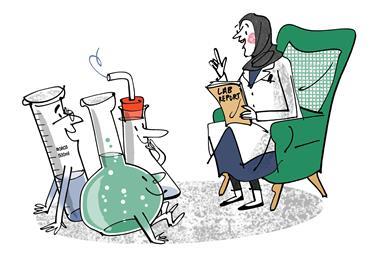From Norman Nicolson
At last someone who is trying to strike a blow at the rubbish published in the newspapers in the name of science. I am a Guardian reader and have made similar comments in the Bad Science section of Guardian Unlimited. There is another writer of a similar ilk, Leo Hickman, who tells us that phenoxy ethanol is friendly, as it is made from grapefruit seeds, it looks like a glycol ether to me. The only fighter on our side is Ben Goldacre who writes a bad science column.
N Nicolson CChem MRSC
By e-mail
From Trevor Kletz
May I add an additional comment to Nina Hall’s article in the July issue. The way chemistry is treated by the press is not unique. I also have an interest in industrial safety, human error, the Near East, country walking and railways. Whenever I read an item on any of these subjects in a newspaper, or hear one on the radio or TV, I see the same half-truths, misunderstandings, sloppy research, un-analytical interpretation and muddled prose that Nina describes. For example, the Daily Telegraph recently printed a map showing the London-Glasgow railway line passing through Manchester. It is a fair conclusion that the reporting of subjects I know little about is equally inaccurate.
The historian Barbara Tuchman has pointed out that when writers deliberately omit facts that do not support their arguments, they are writing fiction.
T A Kletz CChem FRSC
By e-mail
From Laura Boyd
How refreshing it was to read Nina Hall’s Comment in Chemistry World [July 2004]. I have to admit that it is the first article for a long time that has prompted me to pick up my pen (so to speak) and respond. Unfortunately I did not read the supplements referred to in the article, but I too am horrified by misleading items in newspapers and magazines. Ms Hall is spot on when she says that we should ’devote more effort to public understanding of the molecular sciences’.
Of course there are numerous chemicals which are extremely dangerous, and also many everyday chemicals that can be harmful if used incorrectly. However, the reality seems to be that the media is trying to scare the general public into thinking that anything ’unnatural’ or ’chemical’ is bad for you, which clearly is not the case. People need to be more realistic when considering chemicals and their risks.
Assuming that water as a chemical is safe, there are many against water treatment because ’toxic’ chemicals are introduced into the water. Perhaps those people should consider the implications if water was not treated - drinking water from ’naturally’ chemically laden streams into which animals have defecated, leading to third world standards and disease outbreaks. This leads me on to medications - synthesised in a laboratory and therefore not ’natural.’ It would be interesting to see how we could cope without paracetamol, aspirin and antacids, to name but a few common medications found around the home.
Of course, many of these examples are exaggerations, but the fact is that if the media continues to raise alarm in the general public in the way that it is presently, then we may well be heading in that direction! I am now off to get myself a copy of John Emsley’s book!
L J Boyd AMRSC
By e-mail
From Sue Stephens
May I add an additional comment in response to the article in the July issue entitled We’re no dummies, say condom manufacturers. I would like to rectify the statement that ’nitrosamines are added to condoms to improve elasticity’. N-nitrosamines are not, in fact, deliberately added to condom formulations. Small amounts of these potentially harmful chemicals are formed during the rubber curing process due to residues from secondary-amine-based accelerators reacting with nitrogen oxides. These accelerators are widely used to give condoms the properties required in such a demanding application, including elasticity and strength.
S Stephens
By e-mail
From Norman Groocock
I note your comment in the June edition about the absence of a Nobel award for Professor Jeffries. It would be interesting to know whether such awards are usually made to those at ’redbrick’ universities like Leicester (where I studied for a few years). I am also not clear why the commercial exploitation of a ’discovery’ precludes awards. Plenty of money has been made from the manufacture and sale of antibiotics.
Norman Groocock MRSC
By e-mail
From Peter Warneck and Hanns von Weyssenhoff
The article by David Fishlock Enriching uranium in the June issue of Chemistry World gives an interesting account of the development of technologies for the separation of uranium isotopes. But it appears to us that the German contribution to the development of ultra-centrifuges is somewhat misrepresented. We have recently looked into this matter while collecting background material for an article in memory of Wilhelm Groth on the occasion of his 100th birthday. He was one of the first to recognise that centrifuges are optimally suited for the separation of uranium isotopes, because the enrichment factor in this case depends on the mass difference of isotopes and not on the mass ratio as applicable to separation by diffusion.
During the second world war, uranium isotope separation was a task assigned to the Institute for Physical Chemistry in Hamburg under the direction of Paul Harteck, as a contribution to the German uranium project. Groth and Beyerle built the first gas centrifuge for the enrichment of U-235 as UF6, based on the principle of counter-current flow developed by Martin and Kuhn. The first successful experiments were reported in 1942. Technical development proceeded until the end of the war and was resumed afterwards at a research level at the University in Bonn, where Groth had become a full professor in 1950. Ten years later the work became classified again. As a consequence, few results were published in accessible scientific journals. The two major aims: confirming experimentally the theoretically predicted enrichment factors and the development of rotors that minimise friction in the absence of lubricants, were largely achieved.
Gernot Zippe, like many other German scientists and engineers living in the Soviet occupation zone, was taken to Russia shortly after the war to work on the Soviet atomic development programme. There he envisioned the novel ultra-centrifuge design, which used the type of rotor described by David Fishlock. After returning from the Soviet Union in 1956, Zippe worked for Degussa. He also spent some time with Jesse Beams at the University of Virginia, US.
His design solved many of the problems that had plagued earlier constructions; an advantage that soon led to a revival of interest in the technique of centrifugation for the separation of uranium isotopes. Wilhelm Groth has given a lucid account of this development. He deserves credit not only for an early recognition of the advantages of centrifuges in separating uranium isotopes, but also for pursuing the technological development up to the point where industry could take over.
P Warneck MRSC, H von Weyssenhoff
Hannover, Germany.
From Keith Farrer
From Australia, an appreciation of the great readability of Chemistry World, especially the It’s a fungi old world, The eyes have it, and Prosecuting the polluters articles in the May issue.
K T H Farrer CChem FRSC
By e-mail
From Michael Rasburn
I have been a Member of the RSC for a good many years and have followed many a discussion in the letters pages of Chemistry in Britain and now in Chemistry World regarding the pay of chemists. Never in all that time has there been any suggestion that the salaries sought, and obtained, by chemists were outrageous, say in the way that the salaries of MPs, entertainers and so on might be. If outrageous at all, chemist’s salaries have often been noted at the microscopic rather than the macroscopic end of the scale.
Part of the reason for this may rest in the curious way that we are recruited, by industry particularly. Reading the ads for jobs over the years, a singular feature can be discerned. The advertisers hate to mention money. They write fulsomely of the great skills which they seek and what a grand company they are. Not a mention of hard cash - just the breezy ’competitive salary’. The reasons for this could be several, here are three possibilities: a) chemists are notoriously unworldly and need only a handy charity shop and vacant allotment to keep them in style; b) the company is deeply ashamed of the salary which it is offering; c) the company already has several lowly-paid chemists in tow and is trying to complete the set without upsetting the others. Just conceivably; d) the salary is so enormous that, were it to be made public, the shareholders would be in revolt.
As a step to remedying this uncertainty, can I suggest that Chemistry World, refuses to accept job advertisements which do not quote a salary range. Ah, go-on, go-on, go-on - it might do a bit of good!
M Rasburn CChem MRSC
By e-mail
From Leonard Ainsworth
In Fighting for the ozone layer [May 2004], Hamish Kidd equates green propaganda with medical fact when he says ’increased radiation [from ozone depletion] leads to more skin cancers and eye cataracts’. Numerous studies between 1990 and 1998 negated this argument and attributed some observed increases in the incidence of skin cancer to lifestyle changes. The references are to be found in The European Science and Environment Forum’s Working Paper for November 1998. If the ozone layer over the British Isles were to vanish, in a worst-case scenario, then our Solar Erythema Dose would increase by the equivalent of a 60-mile shift towards the equator. Hardly a disaster!
In the 1950s my first graduate post was with a research team developing the use of methyl bromide as a fumigant for stored grain. This chemical has given 40 years of trouble-free global application in agriculture, until the Montreal Protocol came along. Methyl bromide is 2.6 times heavier than air and I suggest that the whole global output so far has been safely leached into the sea (from whence the bromine originated) with only a trace being convected into the stratosphere.
L Ainsworth CChem FRSC
St Annes-on-Sea, UK
From Robert Ramage
With regard to the flashback article by Sallie Robins in the July issue of Chemistry World on Robert Burns Woodward - he was not expelled from MIT. Indeed, it was recognised that he had an exceptional talent as an undergraduate. He had a meteoric academic career at MIT culminating in the award of BS and PhD at the age of 20. He then had the distinction of occupying every rung on the academic ladder at Harvard University, finally becoming the Donner Professor of Science.
R Ramage CChem FRSC
East Lothian, UK












No comments yet